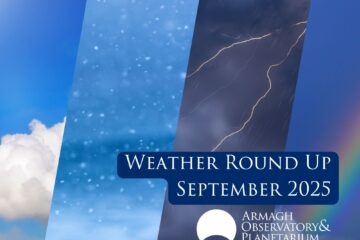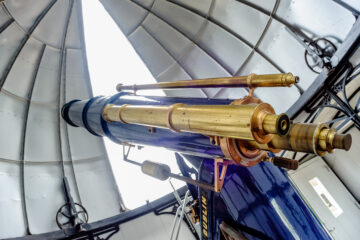NOVEMBER DRIER, WARMER, AND DULLER THAN AVERAGE. AUTUMN 2024 MUCH DRIER, AND SUNNIER AND WARMER THAN AVERAGE
Armagh Observatory, 14th December 2024. Armagh Observatory reports that November 2024 was drier, warmer, and duller than average. Taking September, October, and November together the meteorological autumn at Armagh was much drier than average, the driest autumn at Armagh for eight years. Autumn 2024 was also slightly sunnier than average, although the dullest autumn at Armagh for three years, and warmer than average although the coolest autumn at Armagh for four years.
Total precipitation was 60.05 mm (2.36 inches) including 9 trace values, or 59.6 mm if trace values are ignored. This is approximately 82% of the 183-year (1838-2020) long-term average November precipitation at Armagh (73.85 mm) and 73% of the most recent (1991-2020) 30-year average (81.87 mm). The wettest day was the 22nd with 35.8 mm (1.41 inches) of rainfall, most of which fell in the small hours of the 23rd associated with the passage of a deep depression named Storm Bert. The second wettest day was the 30th with 6.8 mm, much of which was associated with a very heavy shower on the evening of the 30th, Armagh’s Georgian Day. The third wettest day was 6.7 mm on the 18th. These three wet or very wet days supplied more than 80% of the total precipitation for the month.
There were two named storms, namely Storm Bert and Storm Conall. The deep, slow-moving depression called Storm Bert, initially to the west of Ireland, affected large parts of the country during and after the small hours of the 23rd with heavy rainfall and winds at Armagh approaching gale force. Breezy and sometimes windy weather continued the following day and into the 25th. Storm Bert brought flooding to some parts of Northern Ireland and the lowest atmospheric pressure of the month at 09:00 GMT at Armagh, namely 979.0 mbar reduced to mean sea level on the 24th. Storm Conall, on the other hand, only significantly affected parts of southern and south-east England on the 26th and on the morning of the 27th before moving into the Netherlands.
The highest atmospheric pressure of the month was 1042.1 mbar on the 12th. This was, by a small margin, the highest November atmospheric pressure at Armagh for 23 years, that is, since 1042.5 mbar was recorded on the 16th of November 2001. The month was dominated by relatively high pressure, the monthly average being 1018.7 mbar. This, again by a small margin, was the highest average November atmospheric pressure for 17 years, that is, since November 2007 (1020.4 mbar).
A diamond dove, presumably an escapee from an aviary, was seen near the entrance to the Planetarium car park on the afternoon of the 11th. A gull was seen chasing off a heron on the morning of the 20th.
Snow, sleet, and snowflakes, none lying, were observed on four days of a 5-day cold spell lasting from the 18th to the 22nd. A rainbow was seen around the time of observations (09:00 GMT) on the morning of the 25th.
The mean temperature this November was 8.0 degrees Celsius (46.4 Fahrenheit), nearly 1.8 C warmer than the 225-year (1796-2020) long-term average November temperature at Armagh (6.22 C) and 0.7 C warmer than the most recent (1991-2020) 30-year average (7.33 C). It is interesting that when we consider the run of 30-year averages at Armagh, November shows the greatest increase in monthly average temperatures between the (1961-1990) 30-year average and the most recent (1991-2020) 30-year average, approximately 1.2 C in thirty years or 0.4 C per decade.
Even for those without thermometers such a change is quite noticeable. For example, leaves are now remaining on trees until quite late in November, and lawns still need to be cut right up to the end of the month and sometimes into early December. Such phenomena would have been almost unheard of 30 years ago.
The highest maximum air temperature, notionally the warmest day, was 16.9 C on the afternoon of the 6th, followed by 16.0 C around midday on the 7th and 14.9 C on the 23rd. The 6th was the fourth warmest November day on record at Armagh. The five warmest November days at Armagh are now the 11th of November 2022 (17.6 C), the 2nd of November 2005 and the 1st of November 2015 (both 17.2 C), the 6th of November 2024 (16.9 C) and the 2nd of November 1927 (16.8 C).
The lowest maximum air temperature, usually the coolest day, was 1.4 C. This occurred when temperatures were rising rapidly shortly before the weather readings were taken at 09:00 GMT on the 28th. Following standard meteorological practice this lowest daily maximum temperature was assigned to the 27th despite the highest temperature that day (-0.1 C) never exceeding freezing, except shortly before the time of readings on the 28th. Still, the nominal lowest maximum temperature (1.4 C) was the coolest November day at Armagh for 16 years, that is, since a much lower maximum air temperature of -1.5 C was recorded on the 28th of November 2010.
The very cool 27/28 November was followed by the second lowest daily maximum air temperature, namely 4.1 C on the afternoon of the 20th, and then by 4.6 C soon after midday on the 18th.
The highest minimum air temperature, notionally the warmest night, was 13.1 C, which occurred around the time of observations (09:00 GMT) on the 7th. This was followed by 11.3 C on the morning of the 8th and then by 11.0 C on the morning of the 30th. The lowest minimum air temperature, usually the coolest night, was -4.3 C on the morning of the 28th, followed by -2.9 C shortly after the observations were taken at 09:00 GMT on the 21st but attributed to the 22nd, and by -2.9 C in the small hours of the 27th.
There were 15 nights with ground frost, the coldest three of which were -7.7 C on the 21st, -6.9 C on the 22nd, and -6.8 C on the 20th. There were five nights with nighttime air frost, of which the three coolest were those just mentioned, namely -4.3 C on the morning of the 28th, and -2.9 C attributed to the 22nd and -2.9 C on the 27th.
There were 46.5 hours of strong sunshine this November, approximately 78% of the 140-year (1881-2020) long-term average November sunshine at Armagh (59.6 hours) and 75% of the most recent (1991-2020) 30-year average (61.8 hours). This was the dullest November at Armagh for nine years, that is, since November 2015 (44.4 hours of strong sunshine).
November 2024 was remarkable for the extraordinarily dull start to the month, the fortnight beginning the 27th of October 2024 seeing a total of just 2.4 hours of strong sunshine at Armagh, and the seven days from the 30th of October to the 5th of November seeing not a single minute of strong sunshine. A sequence of 7 sunless days during the months of October and November at Armagh occurs on average only once every approximately 50 years.
The sunniest day was the 26th with 7.1 hours of strong sunshine followed by the 24th with 6.3 hours and the 21st with 5.3 hours.
Taking the three autumn months September, October, and November together, autumn 2024 was much drier than average, and warmer and sunnier than average.
Total autumn precipitation was 161.25 mm including 23 trace values, which is just 72% of the 183-year long-term (1838-2020) average autumn rainfall at Armagh (223.2 mm) and 71% of the most recent (1991-2020) 30-year average (227.9 mm). This was the driest autumn at Armagh for eight years, that is, since autumn 2016 (144.1 mm).
With an average temperature of 10.82 C, autumn 2024 was again warmer than average, approximately 1.4 C warmer than the 225-year (1796-2020) long-term average autumn temperature at Armagh (9.41 C), and 0.4 C warmer than the most recent (1991-2020) 30-year autumn average (10.40 C). Despite this, autumn 2024 was the coolest autumn at Armagh for four years, that is, since autumn 2020 (mean temperature 10.65 C).
Total autumn sunshine was 283.9 hours, just under 10% more than the 140-year (1881-2020) long-term autumn average at Armagh (259.0 hours) and 6% more than the most recent (1991-2020) 30-year autumn average (268.1 hours).
These data refer to observations at Armagh Observatory, which has been recording the weather at Armagh since 1795.
For further information, please contact:
Professor Mark E. Bailey
Emeritus Director of Armagh Observatory
Armagh Observatory and Planetarium
College Hill
Armagh
BT61 9DG
Tel: 028-3752-2928
E-mail: mark.bailey@armagh.ac.uk



0 Comments